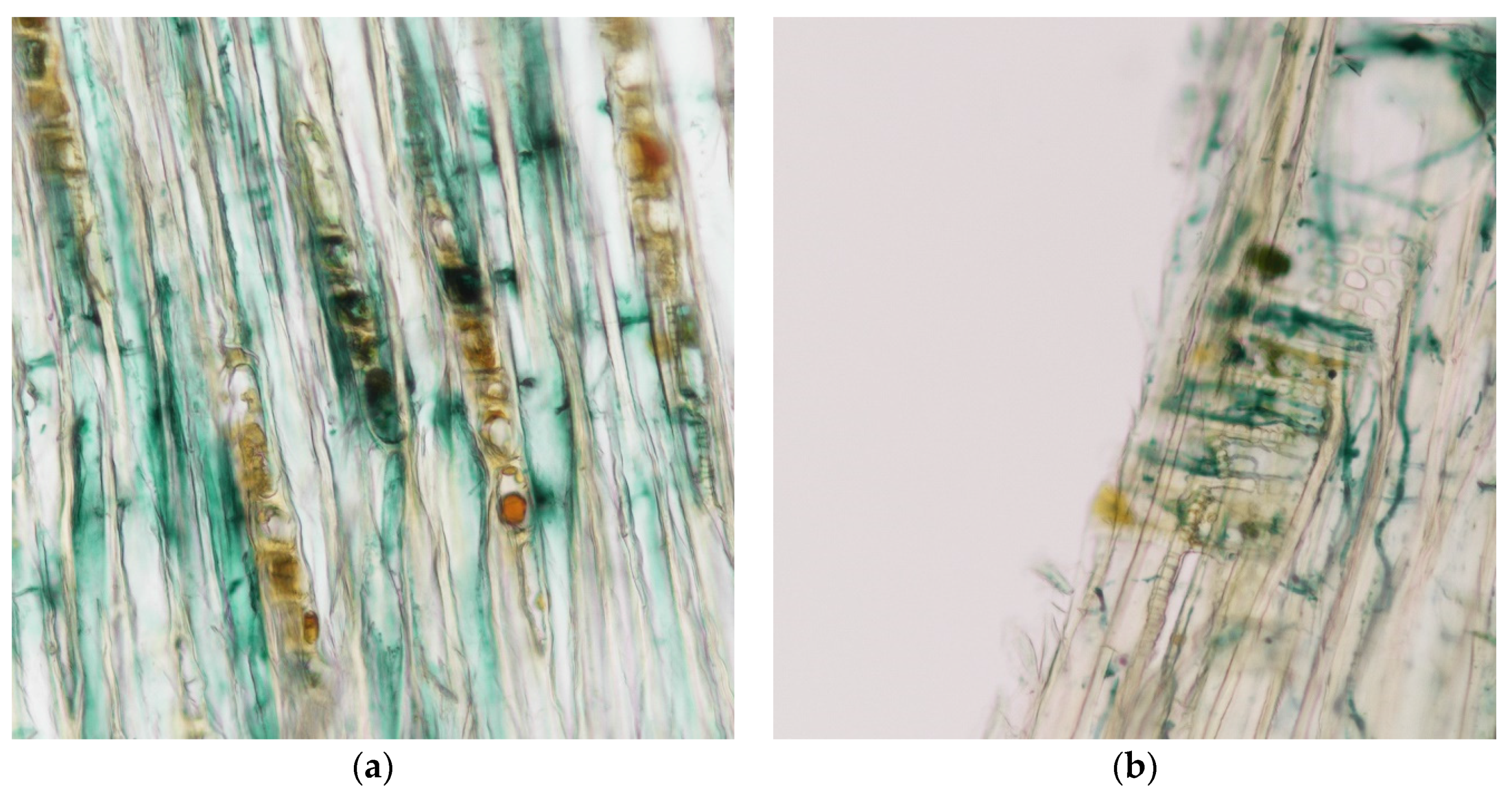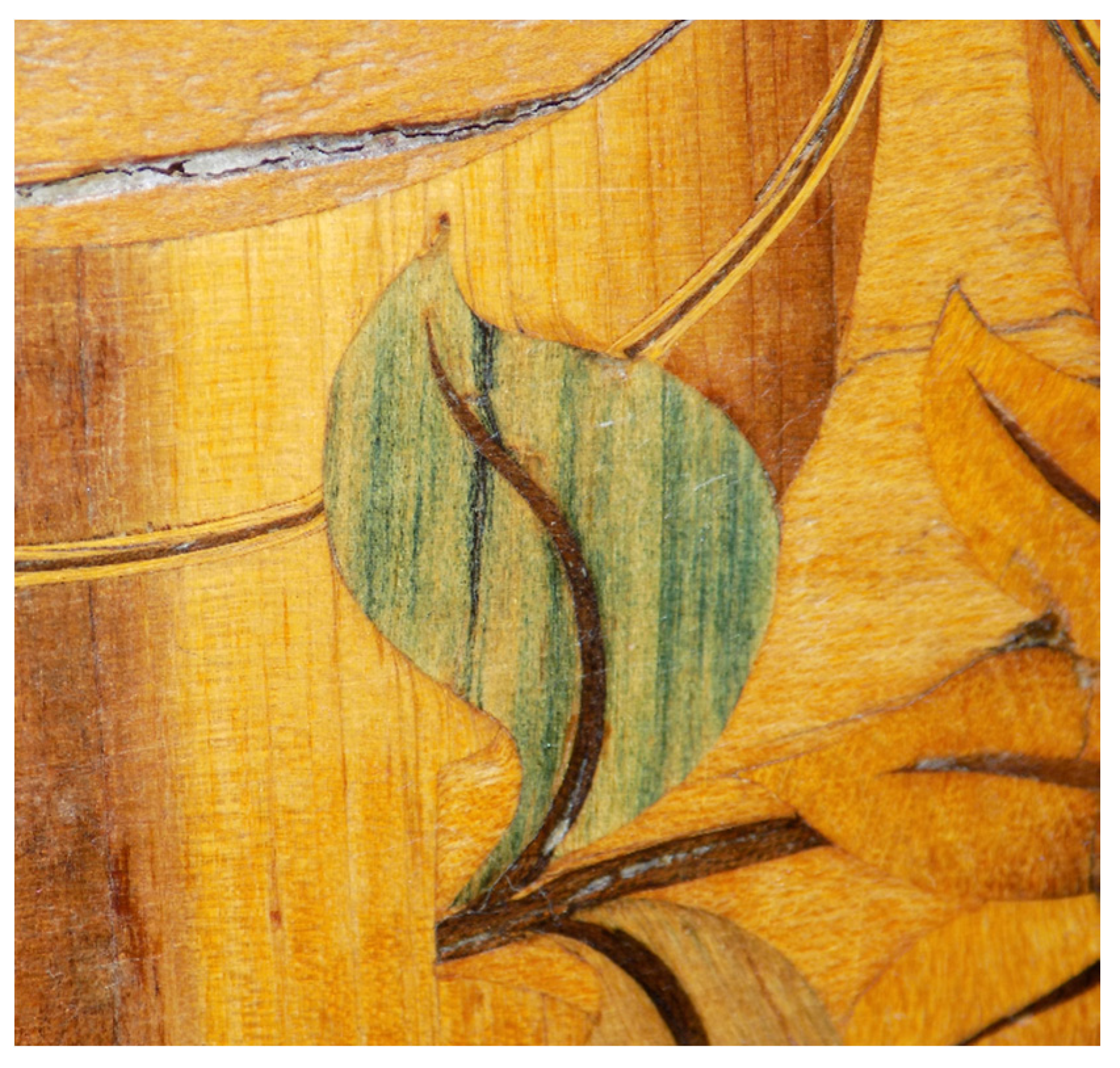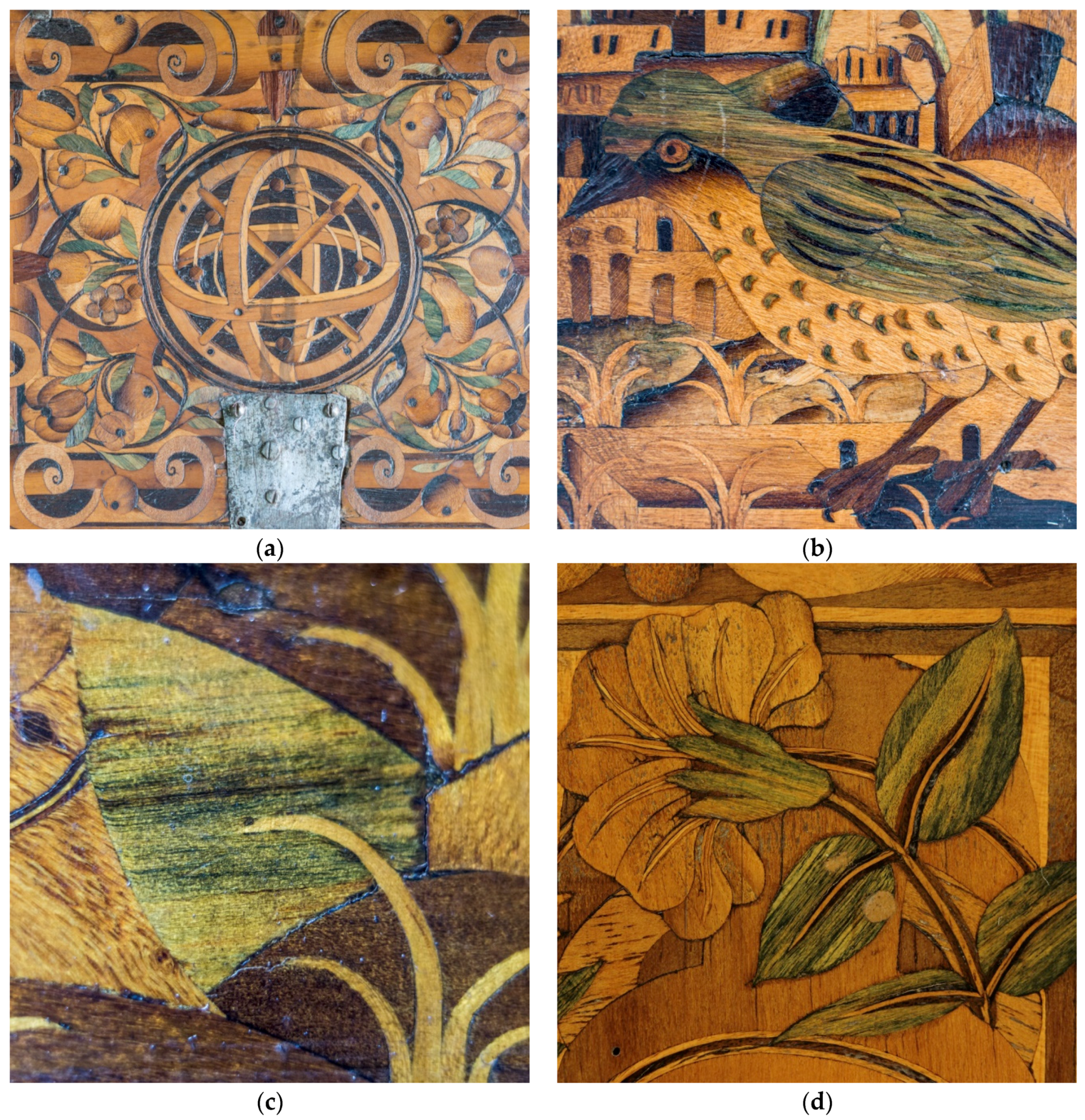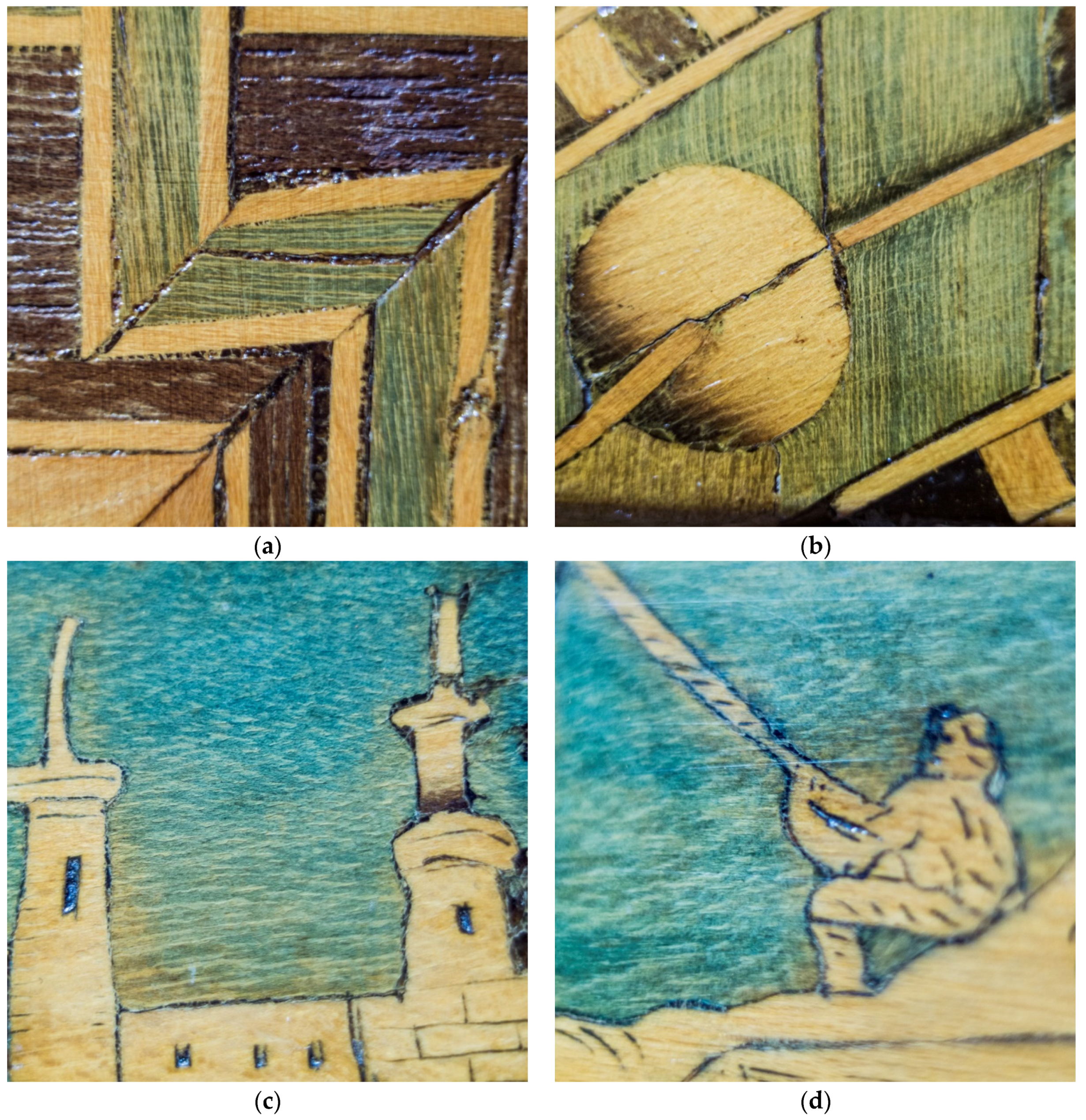Determining the Presence of Spalted Wood in Spanish Marquetry Woodworks of the 1500s through the 1800s
Abstract
:1. Introduction
2. Materials and Methods
2.1. Location of Potential Spalted Wood Pieces
2.2. Museum Information and Access
2.3. Data Collection and Analysis
3. Results
3.1. Background of the Time Period
3.2. Science behind the Spalting Determination
3.3. The Artwork—Spalted
3.4. The Artwork—Not Spalted
4. Discussion
5. Conclusions
Acknowledgments
Author Contributions
Conflicts of Interest
References
- Robinson, S.C.; Michaelsen, H.; Robinson, J.C. Spalted Wood, History, Science and Art of an Unique Material; Schiffer Publishing: Atglen, PA, USA, 2016. [Google Scholar]
- Robinson, S.C.; Laks, P.E.; Richter, D.L.; Pickens, J. Evaluating loss of machinability in spalted sugar maple. Forest Prod. J. 2007, 57, 33–37. [Google Scholar]
- Mallett, K.I.; Hiratsuka, Y. Nature of the “black line” produced between different biological species of the Armillaria mellea complex. Can. J. Bot. 1986, 64, 2588–2590. [Google Scholar] [CrossRef]
- Zabel, R.A.; Morrell, J.J. Wood Microbiology Decay and Its Prevention; Academic Press: San Diego, CA, USA, 1992. [Google Scholar]
- Robinson, S.C.; Tudor, D.; Cooper, P.A. Wood preference of spalting fungi in urban hardwood species. Int. Biodeterior. Biodegrad. 2011, 65, 1145–1149. [Google Scholar] [CrossRef]
- Robinson, S. Developing fungal pigments for “painting” vascular plants. Appl. Microbiol. Biotechnol. 2012, 93, 1389–1394. [Google Scholar] [CrossRef] [PubMed]
- Robinson, S.C.; Tudor, D.; Cooper, P. Utilizing pigment-producing fungi to add commercial value to American beech (Fagus grandifolia). Appl. Microbiol. Biotechnol. 2012, 93, 1041–1048. [Google Scholar] [CrossRef] [PubMed]
- Robinson, S.; Tudor, D.; Hipson, S.; Snider, H.; Ng, S.; Korshikov, E.; Cooper, P. Methods of inoculating Acer spp., Populus tremuloides, and Fagus grandifolia logs for commercial spalting applications. J. Wood Sci. 2013, 59, 351–357. [Google Scholar] [CrossRef]
- Robinson, S.C.; Tudor, D.; Zhang, W.R.; Ng, S.; Cooper, P.A. Ability of three yellow pigment producing fungi to colour wood under controlled conditions. Int. Wood Prod. J. 2014, 5, 103–107. [Google Scholar] [CrossRef]
- Robinson, S.C.; Hinsch, E.; Weber, G.; Leipus, K.; Cerney, D. Wood colorization through pressure treating: the potential of extracted colorants from spalting fungi as a replacement for woodworkers’ aniline dyes. Materials 2014, 7, 5427–5437. [Google Scholar] [CrossRef] [PubMed]
- Weber, G.; Chen, H.-L.; Hinsch, E.; Freitas, S.; Robinson, S.C. Pigments extracted from the wood-staining fungi Chlorociboria aeruginosa, Scytalidium cuboideum, and S. ganodermophthorum show potential for use as textile dyes. Color. Technol. 2014, 130, 445–452. [Google Scholar] [CrossRef]
- Vega Gutiérrez, S.M.; Robinson, S.C. Initial studies on the diversity of spalting fungi in the southern amazon forest of peru. In The Challenge of Complexity; Società Italiana di Microbiologia Agraria-Alimentare e Ambientale: Florence, Italy, 2015; pp. 59–60. [Google Scholar]
- Vega Gutiérrez, S.M.; Robinson, S.C. Microscopic analysis of pigments extracted from spalting fungi. J. Fungi 2017, 3, 15. [Google Scholar] [CrossRef]
- Vega Gutierrez, S.M. Spalting Fungi: Genetic Identification, Material Interactions and Microscopical Characteristics of Extracted Pigments. Ph.D. Thesis, Oregon State University, Corvallis, OR, USA, 2017. [Google Scholar]
- Vega Gutiérrez, S.M.; Vega Gutiérrez, P.T.; Godinez, A.; Pittis, L.; Huber, H.; Stanton, S.; Robinson, S.C. Feasibility of coloring bamboo with the application of natural and extracted fungal pigments. Coatings 2016, 6, 37. [Google Scholar] [CrossRef]
- Blanchette, R.A.; Wilmering, A.M.; Baumeister, M. The use of green-stained wood caused by the fungus Chlorociboria in intarsia masterpieces from the 15th century. Holzforsch Int. J. Biol. Chem. Phys. Technol. Wood 1992, 46, 225–232. [Google Scholar]
- Richter, D.L.; Glaeser, J.A. Wood decay by Chlorociboria aeruginascens (Nyl.) Kanouse (Helotiales, Leotiaceae) and associated basidiomycete fungi. Int. Biodeterior. Biodegrad. 2015, 105, 239–244. [Google Scholar] [CrossRef]
- Michaelsen, H.; Unger, A.; Fischer, C.-H. Blaugrüne Färbung an Intarsienhölzern des 16. und bis 18. Jahrhunderts. Restauro 1992, 98, 17–25. (In German) [Google Scholar]
- Otterstedt, A. Investigating green marquetry on bowed-string instruments. The leaves be greene. Galpin Soc. J. 2001, 54, 330–338. [Google Scholar] [CrossRef]
- Aguiló-Alonso, M.P. In search of wisdom: An iconographic programme in a 16th-century German bureau with marquetry. In Bulletin Bilbao Fine Arts Museum; Bilbao Fine Arts Museum: Bizkaia, Spain, 2010; No. 5; pp. 15–63. [Google Scholar]
- Hellwag, F. Die Geschichte des Deutschen Tischlerhandwerks: Vom 12. Bis Zum 20. Jahrhundert; Verlag-Anst. des Dt. Holzarbeiter-Verbandes: Berlin, Germany, 1924. (In German) [Google Scholar]
- Scherer, C. Technik und Geschichte der Intarsia; TOWeigel Nachfolger: Leipzig, Germany, 1891. (In German) [Google Scholar]
- Cer.es. Red Digital de Colecciones de Museos de Espana. Available online: http://ceres.mcu.es (accessed on 6 June 2017).
- Aguiló Alonso, M.P. La Ebanisteria Alemana en el Monasterio del Escorial; Consejo Superior de Investigaciones Científicas (España): Madrid, Spain, 1987. (In Spanish) [Google Scholar]
- Piera Miquel, M. Los Muebles con Secreto: Esconder, Exhibir, Aprender. Rev. Hist. Mod. An. Univ. Alicante 2012, 30, 159–175. [Google Scholar] [CrossRef]
- Whishaw, B.; Whishaw, E.M. Arabic Spain, Sidelights on Her History and Art; Smith, Elder & Co.: London, UK, 1912. [Google Scholar]
- Aguiló Alonso, M.P. El Mueble en España, Siglos XVI–XVII; Antiqvaria: Minneapolis, MN, USA, 1993. [Google Scholar]
- Perez de Tudela, A. Los Muebles de la Colección de Felipe II y de su Hija la Infanta Isabel Clara Eugenia. In El Culto al Objeto: De la Vida Cotidiana a la Colección; Asociación para el Estudio del Mueble: Barcelona, Spain, 2009; pp. 33–47. (In Spanish) [Google Scholar]
- Aguiló Alonso, M.P. Relaciones Entre España e Italia en el Siglo XVII. La Importación de Objetos de lujo; Ayuntamiento: Barcelona, Spain, 2007; pp. 37–47. (In Spanish) [Google Scholar]
- Edwards, R.L.; Kale, N. The structure of xylindein. Tetrahedron 1965, 21, 2095–2107. [Google Scholar] [CrossRef]
- Liebermann, C. Ueber Xylindein. Ber. Dtsch. Chem. Ges. 1874, 7, 1102–1103. [Google Scholar] [CrossRef]
- Tudor, D.; Margaritescu, S.; Sánchez-Ramírez, S.; Robinson, S.C.; Cooper, P.A.; Moncalvo, J.M. Morphological and molecular characterization of the two known North American Chlorociboria species and their anamorphs. Fungal Biol. 2014, 118, 732–742. [Google Scholar] [CrossRef] [PubMed]
- Tudor, D.; Robinson, S.C.; Krigstin, T.L.; Cooper, P.A. Microscopic investigation on fungal pigment formation and its morphology in wood substrates. Open Mycol. J. 2014, 8, 174–186. [Google Scholar] [CrossRef]
- Blanchette, R.A. Screening wood decayed by white rot fungi for preferential lignin degradation. Appl. Environ. Microbiol. 1984, 48, 647–653. [Google Scholar] [PubMed]
- Blanchette, R.A. Degradation of the lignocellulose complex in wood. Can. J. Bot. 1995, 73, 999–1010. [Google Scholar] [CrossRef]
- Fichas de Piezas del MNAD; Museo Nacional de Artes Decorativas: Madrid, Spain, 2015. (In Spanish)





| # | Code | Object | Date | Origin | Image Resolution | Camera |
|---|---|---|---|---|---|---|
| National Museum of Decorative Arts | ||||||
| 1 | CE02218 | Bureau | 1600 | South Germany | 254 dpi | Nikon D800 |
| Olympus E-M5 | ||||||
| 2 | CE02735 | Bureau | 1600 | South Germany | 254 dpi | Nikon D800 |
| 3 | CE02845 | Bureau | 1601 | South Germany | 254 dpi | Nikon D800 |
| 4 | CE05638 | Cabinet | 1801 | Spain | 254 dpi | Nikon D800 |
| 150 dpi | Olympus E-M5 | |||||
| 5 | CE05648 | Cabinet | 1801 | Spain | 150 dpi | Nikon D800 |
| 6 | CE05725 | Cabinet | 1776 | Italy/Spain | 150 dpi | Nikon D800 |
| 7 | CE19340 | Game table | 1776 | Spain | 254 dpi | Nikon D800 |
| Bilbao Fine Arts Museum | ||||||
| 8 | 82/1477 | Bureau | 1560–1570 | South Germany | 350 dpi | Canon EOS 1100D |
| 9 | 82/2472 | Table | 1560–1570 | South Germany | 350 dpi | Canon EOS 400D Digital |
| Royal Monastery San Lorenzo El Escorial | ||||||
| 10 | – | Doors | 1560–1570 | South Germany | 300 dpi | Nikon Coolpix L340 |
| Component | Presence and Form | |
|---|---|---|
| Blue-green colored inlaid pieces (Blue-green) | ☒ Present | ☐ Not present |
| Pigment in ray cells (Pigm-ray) | ☒ Present | ☐ Not present |
| Pigment highly concentrated in ray cells (Concent.) | ☒ Present | ☐ Not present |
| Overall color distribution (Dist.) | ☐ Regular | ☒ Irregular |
| Inlaid piece size (Size) | ☒ < 10 cm | ☐ > 10 cm |
| Date (Date) | ☒ < 1650 | ☐ > 1650 |
| # | Code | Object | Origin | Blue Green | Pigm-Ray | Concent. | Dist. | Size | Date |
|---|---|---|---|---|---|---|---|---|---|
| 1 | CE02218 | Bureau | South Germany | Present | Present | Present | Irregular | <10 cm | <1650 |
| 2 | CE02735 | Bureau | South Germany | Present | Present | Present | Irregular | <10 cm | <1650 |
| 3 | CE02845 | Bureau | South Germany | Present | Present | Present | Irregular | <10 cm | <1650 |
| 4 | CE05638 | Cabinet | Spain | Present | Present | Present | Irregular | <10 cm | <1650 |
| 5 | CE05648 | Cabinet | Spain | Present | Not present | Not present | Regular | >10 cm | >1650 |
| 6 | CE05725 | Cabinet | Italy/Spain | Present | Not present | Not present | Regular | >10 cm | >1650 |
| 7 | CE19340 | Game table | Spain | Present | Not present | Not present | Regular | >10 cm | >1650 |
| 8 | 82/1477 | Bureau | South Germany | Present | Present | Present | Irregular | <10 cm | <1650 |
| 9 | 82/2472 | Table | South Germany | Present | Present | Present | Irregular | <10 cm | <1650 |
| 10 | NA | Doors | South Germany | Present | Present | Present | Irregular | <10 cm | <1650 |
© 2017 by the authors. Licensee MDPI, Basel, Switzerland. This article is an open access article distributed under the terms and conditions of the Creative Commons Attribution (CC BY) license (http://creativecommons.org/licenses/by/4.0/).
Share and Cite
Vega Gutierrez, P.T.; Robinson, S.C. Determining the Presence of Spalted Wood in Spanish Marquetry Woodworks of the 1500s through the 1800s. Coatings 2017, 7, 188. https://doi.org/10.3390/coatings7110188
Vega Gutierrez PT, Robinson SC. Determining the Presence of Spalted Wood in Spanish Marquetry Woodworks of the 1500s through the 1800s. Coatings. 2017; 7(11):188. https://doi.org/10.3390/coatings7110188
Chicago/Turabian StyleVega Gutierrez, Patricia T., and Seri C. Robinson. 2017. "Determining the Presence of Spalted Wood in Spanish Marquetry Woodworks of the 1500s through the 1800s" Coatings 7, no. 11: 188. https://doi.org/10.3390/coatings7110188





